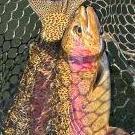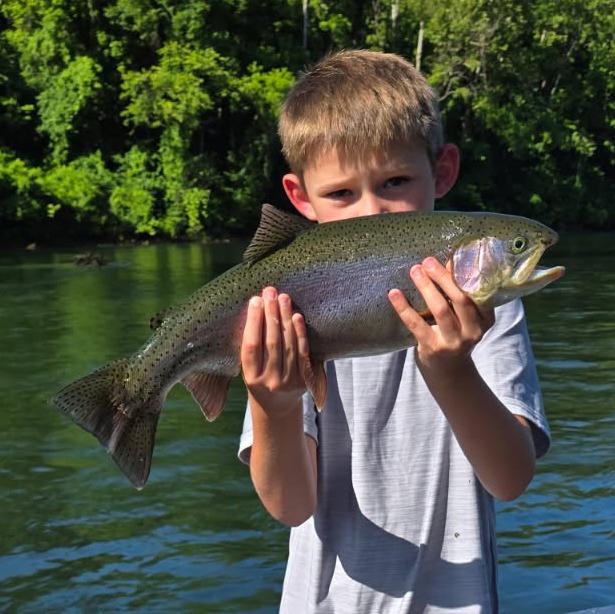Leaderboard
Popular Content
Showing content with the highest reputation since 12/12/2024 in Articles
-

Lilley's Lake Taneycomo Fishing Report, September 17
Jighog and one other reacted to Phil Lilley for a article
Trout fishing on Lake Taneycomo has been pretty good the last few weeks. About six weeks ago, a big number of rainbow trout were stocked in short order. My understanding was that our hatcheries were over crowded, and officials had to reduce numbers. These rainbows were a little on the small side, and most were stocked well below Branson, but they've made their way up lake. Catching trout has been good lately! Newly stocked trout are generally easy to catch. They're not very smart. They've been hand fed all their lives, so they're going to eat or chase about anything they see for a while. So spinners and spoons, flies and baits under floats and bait on the bottom -- all are effective for these fish. Generation has been consistent with no water running at night and in the morning. Then early to mid-afternoon, operators are running as little as one unit and up to all four units, most of the time until dark or after. It's September, and our water flowing from Table Rock Lake is low in oxygen. This is seasonal and not surprising. When they run water, liquid oxygen is injected into the turbines, and that keeps lake water safe for our fish. I personally have not seen the trout lethargic, lacking fight. On the contrary, they have been fighting pretty hard. But you do need to keep this in mind when you catch and release. Land them as quickly as you can, keep them in the water while unhooking them and ideally release without taking them out of the water. If you want pictures, take them quickly! Article: Seasonal Oxygen Issues & Handling Trout, Lake Taneycomo As I reported, fish have been chasing spoons, especially when the water is running. Also jerk baits late in the evening and past dark with the water running have worked fairly well. Black jigs have been the best after dark for catching bigger trout. Throwing jigs (without a float) has also been good. I'm using two-pound line most of the time now except when four units are running and I'm throwing 1/8th ounce jigs -- then I'm using four-pound line. Best colors have been brown, sculpin, black, white and sculpin/ginger. Under a float, we're using jigs, mega worm, beaded scud, zebra midges and pink Powerworm. Best jig color for me has been the sculpin jig with an indy-orange head. I'm using two-pound line. Find the chop on the water for the best fishing. Wind helps! Baits - night crawlers are still the best bait, although Powerbaits are catching those stocker rainbows. Use two- or four-pound line. When the water is running, drift flies or bait on the bottom. Again, worms are the best, but drifting scuds is pretty good, too. Try a #12 gray scud or an egg fly, both in the trophy are and below it. Fly fishing - the trophy area still is the best place to fly fish, although you can do well below the line fishing flies under an indicator. In the mornings, fish a zebra midge under a float using 6 or 7x tippet, #16 or #18 black, red or olive midge. Fish a scud under an indicator close to the bottom. Try a #14 to #18 gray or olive scud using 6 or 7x tippet. If you're in choppy water, strip a wooly bugger, crackleback, sculpin or other medium-to-small streamer.2 points -

Lilley's Lake Taneycomo fishing report, July, 2025
ness reacted to Phil Lilley for a article
We've seen a great deal of water pass our dock this spring and summer! And it continues to run but there's a light at the end of this tunnel. Table Rock Lake is dropping one foot every 3 days and is almost down to it's power pool lever (917 feet). Before it gets there, I predict we'll see some variation of flows and possibly some periods when the water is off. We will see. It's below 919 feet now and they're still running 3 units at about 10,000 cfs. By the time we publish this report, flows may have changed. Fishing on Lake Taneycomo has been fair for most of the summer. I say fair because it's been tough for most anglers. But the past couple of weeks it has improved. It's been tough I think because of the heavy flows which has not stopped in well over a month. It's just simply hard to get a lure or bait to the bottom where most of the fish are holding. Some have mastered it. Our guides are consistently reporting catches of trophy trout most days - there are good numbers of 20+ inch rainbows and browns in the lake. I have personally caught 5 trophy rainbows this week, all on the 1/16th-ounce sculpin/ginger jig with a brown head. All the rainbows have been in the trophy area except one. Several guides have told me their clients have landed up to 3 trophies in an 4-hour trip. Captain Blake Wilson says the bite actually isn't picking up till later in the morning, about 9 a.m. lately. In the trophy area, they're been drifting the following flies on drift rigs and using the Provo Rig: #12 tan scuds, fl.orange egg fly, cream mega worm, cerise San Juan worm. As the water slows down, instead of using a #12 scud, use a smaller size, down to a #16. These flies do work below Fall Creek but you can switch to Powerbait and worms. Both have been doing pretty good. Gulp Eggs in white and orange have been the best. We have had a few trophies caught and released below Fall Creek using night crawlers. I have talked to guests here at the resort drifting bait the last couple of weeks and one thing is for sure -- there's no one hot spot. Usually I advise people to drift from Fall Creek to Short Creek or go down by Monkey Island or the Landing. But right now, all those places are good, plus drifting down in front of our place. Rainbows seems to be spread our throughout this area.1 point



